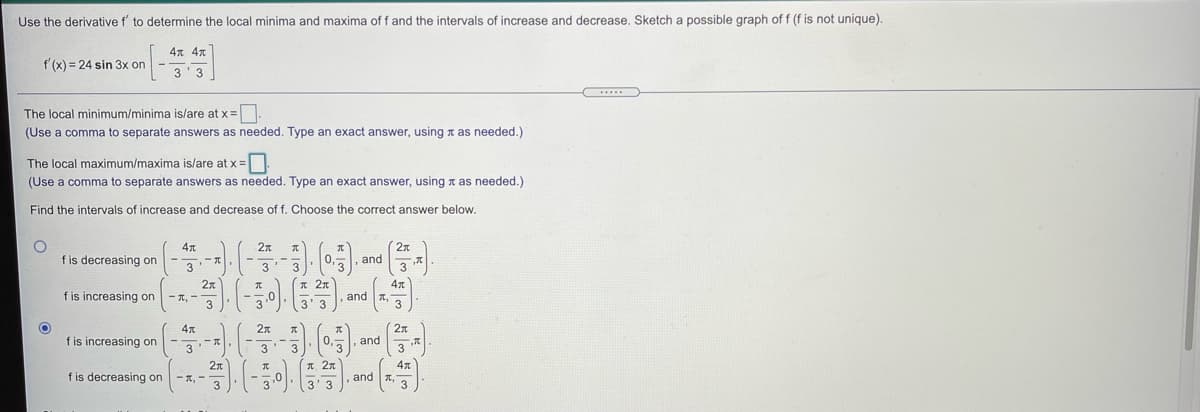Use the derivative f' to determine the local minima and maxima of f and the intervals of increase and decrease. Sketch a possible graph of f (f is not unique). 4x 4x f'(x) = 24 sin 3x on 3'3 The local minimum/minima is/are at x=. (Use a comma to separate answers as needed. Type an exact answer, using t as needed.) The local maximum/maxima is/are at x = (Use a comma to separate answers as needed. Type an exact answer, using t as needed.) Find the intervals of increase and decrease of f. Choose the correct answer below. 27 f is decreasing on and 2n f is increasing on 30 and 2n f is increasing on and 3 3 T 2n f is decreasing on 3.0 and
Use the derivative f' to determine the local minima and maxima of f and the intervals of increase and decrease. Sketch a possible graph of f (f is not unique). 4x 4x f'(x) = 24 sin 3x on 3'3 The local minimum/minima is/are at x=. (Use a comma to separate answers as needed. Type an exact answer, using t as needed.) The local maximum/maxima is/are at x = (Use a comma to separate answers as needed. Type an exact answer, using t as needed.) Find the intervals of increase and decrease of f. Choose the correct answer below. 27 f is decreasing on and 2n f is increasing on 30 and 2n f is increasing on and 3 3 T 2n f is decreasing on 3.0 and
Calculus: Early Transcendentals
8th Edition
ISBN:9781285741550
Author:James Stewart
Publisher:James Stewart
Chapter1: Functions And Models
Section: Chapter Questions
Problem 1RCC: (a) What is a function? What are its domain and range? (b) What is the graph of a function? (c) How...
Related questions
Question
Please help solve!

Transcribed Image Text:Use the derivative f' to determine the local minima and maxima of f and the intervals of increase and decrease. Sketch a possible graph of f (f is not unique).
4x 47
f'(x) = 24 sin 3x on
3'3
...
The local minimum/minima is/are at x=.
(Use a comma to separate answers as needed. Type an exact answer, using t as needed.)
The local maximum/maxima is/are at x =.
(Use a comma to separate answers as needed. Type an exact answer, using t as needed.)
Find the intervals of increase and decrease of f. Choose the correct answer below.
f is decreasing on
3
and
2n
f is increasing on
T,-
and
3
2n
f is increasing on
and
3 3
T 2n
f is decreasing on
3.0
and
Expert Solution
This question has been solved!
Explore an expertly crafted, step-by-step solution for a thorough understanding of key concepts.
This is a popular solution!
Trending now
This is a popular solution!
Step by step
Solved in 2 steps with 1 images

Recommended textbooks for you

Calculus: Early Transcendentals
Calculus
ISBN:
9781285741550
Author:
James Stewart
Publisher:
Cengage Learning

Thomas' Calculus (14th Edition)
Calculus
ISBN:
9780134438986
Author:
Joel R. Hass, Christopher E. Heil, Maurice D. Weir
Publisher:
PEARSON

Calculus: Early Transcendentals (3rd Edition)
Calculus
ISBN:
9780134763644
Author:
William L. Briggs, Lyle Cochran, Bernard Gillett, Eric Schulz
Publisher:
PEARSON

Calculus: Early Transcendentals
Calculus
ISBN:
9781285741550
Author:
James Stewart
Publisher:
Cengage Learning

Thomas' Calculus (14th Edition)
Calculus
ISBN:
9780134438986
Author:
Joel R. Hass, Christopher E. Heil, Maurice D. Weir
Publisher:
PEARSON

Calculus: Early Transcendentals (3rd Edition)
Calculus
ISBN:
9780134763644
Author:
William L. Briggs, Lyle Cochran, Bernard Gillett, Eric Schulz
Publisher:
PEARSON

Calculus: Early Transcendentals
Calculus
ISBN:
9781319050740
Author:
Jon Rogawski, Colin Adams, Robert Franzosa
Publisher:
W. H. Freeman


Calculus: Early Transcendental Functions
Calculus
ISBN:
9781337552516
Author:
Ron Larson, Bruce H. Edwards
Publisher:
Cengage Learning